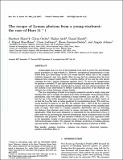Por favor, use este identificador para citar o enlazar a este item:
http://hdl.handle.net/10261/13014COMPARTIR / EXPORTAR:
 SHARE SHARE
 CORE
BASE CORE
BASE
|
|
| Visualizar otros formatos: MARC | Dublin Core | RDF | ORE | MODS | METS | DIDL | DATACITE | |

| Título: | The escape of Lyman photons from a young starburst: the case of Haro 11 |
Autor: | Hayes, Matthew; Östlin, G.; Atek, Hakim; Kunth, Daniel; Mas-Hesse, J. Miguel CSIC ORCID ; Leitherer, Claus; Jiménez-Bailón, Elena; Adamo, Angela | Palabras clave: | Galaxies: evolution Galaxies: individual: Haro 11 Galaxies: star clusters Ultraviolet: galaxies |
Fecha de publicación: | 26-nov-2007 | Editor: | Royal Astronomical Society Blackwell Publishing |
Citación: | Monthly Notices of the Royal Astronomical Society 382(4): 1465-1480 (2007) | Resumen: | Lyman α (Lyα) is one of the dominant tools used to probe the star-forming galaxy population at high redshift (z). However, astrophysical interpretations of data drawn from Lyα alone hinge on the Lyα escape fraction which, due to the complex radiative transport, may vary greatly. Here, we map the Lyα emission from the local luminous blue compact galaxy Haro 11, a known emitter of Lyα and the only known candidate for low-z Lyman continuum emission. To aid in the interpretation, we perform a detailed ultraviolet and optical multiwavelength analysis and model the stellar population, dust distribution, ionizing photon budget, and star-cluster population. We use archival X-ray observations to further constrain properties of the starburst and estimate the neutral hydrogen column density. The Lyα morphology is found to be largely symmetric around a single young star-forming knot and is strongly decoupled from other wavelengths. From general surface photometry, only very slight correlation is found between Lyα and Hα, E(B−V) , and the age of the stellar population. Only around the central Lyα bright cluster do we find the Lyα/Hα ratio at values predicted by the recombination theory. The total Lyα escape fraction is found to be just 3 per cent. We compute that ∼90 per cent of the Lyα photons that escape do so after undergoing multiple resonance scattering events, masking their point of origin. This leads to a largely symmetric distribution and, by increasing the distance that photons must travel to escape, decreases the escape probability significantly. While dust must ultimately be responsible for the destruction of Lyα, it plays a little role in governing the observed morphology, which is regulated more by interstellar medium kinematics and geometry. We find tentative evidence for local Lyα equivalent width in the immediate vicinity of star clusters being a function of cluster age, consistent with hydrodynamic studies. We estimate the intrinsic production of ionizing photons and put further constraints of ∼9 per cent on the escaping fraction of photons at 900 Å. |
Descripción: | 16 pages, 9 figures, 8 tables, 1 appendix.-- ISI Article Identifier: 000251672100007.-- ArXiv pre-print available at: http://arxiv.org/abs/0710.2622 | Versión del editor: | http://dx.doi.org/10.1111/j.1365-2966.2007.12482.x | URI: | http://hdl.handle.net/10261/13014 | DOI: | 10.1111/j.1365-2966.2007.12482.x | ISSN: | 0035-8711 |
| Aparece en las colecciones: | (CAB) Artículos |
Ficheros en este ítem:
| Fichero | Descripción | Tamaño | Formato | |
|---|---|---|---|---|
| Lyman_photons.pdf | 1,15 MB | Adobe PDF |  Visualizar/Abrir |
CORE Recommender
SCOPUSTM
Citations
69
checked on 31-mar-2024
WEB OF SCIENCETM
Citations
76
checked on 21-feb-2024
Page view(s)
418
checked on 18-abr-2024
Download(s)
249
checked on 18-abr-2024
Google ScholarTM
Check
Altmetric
Altmetric
NOTA: Los ítems de Digital.CSIC están protegidos por copyright, con todos los derechos reservados, a menos que se indique lo contrario.
